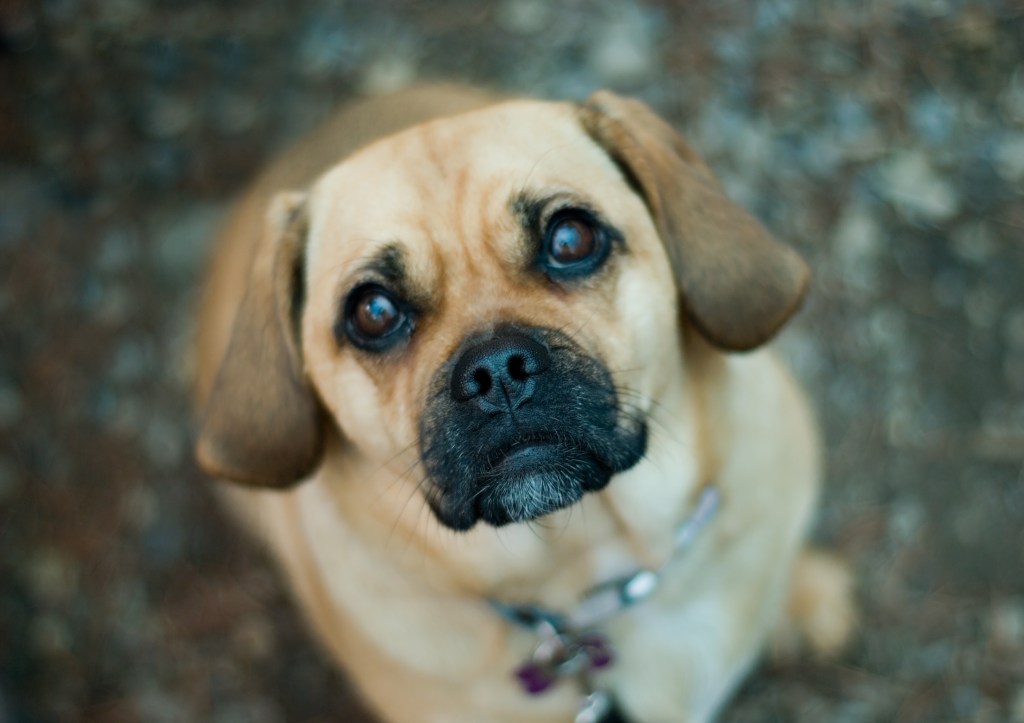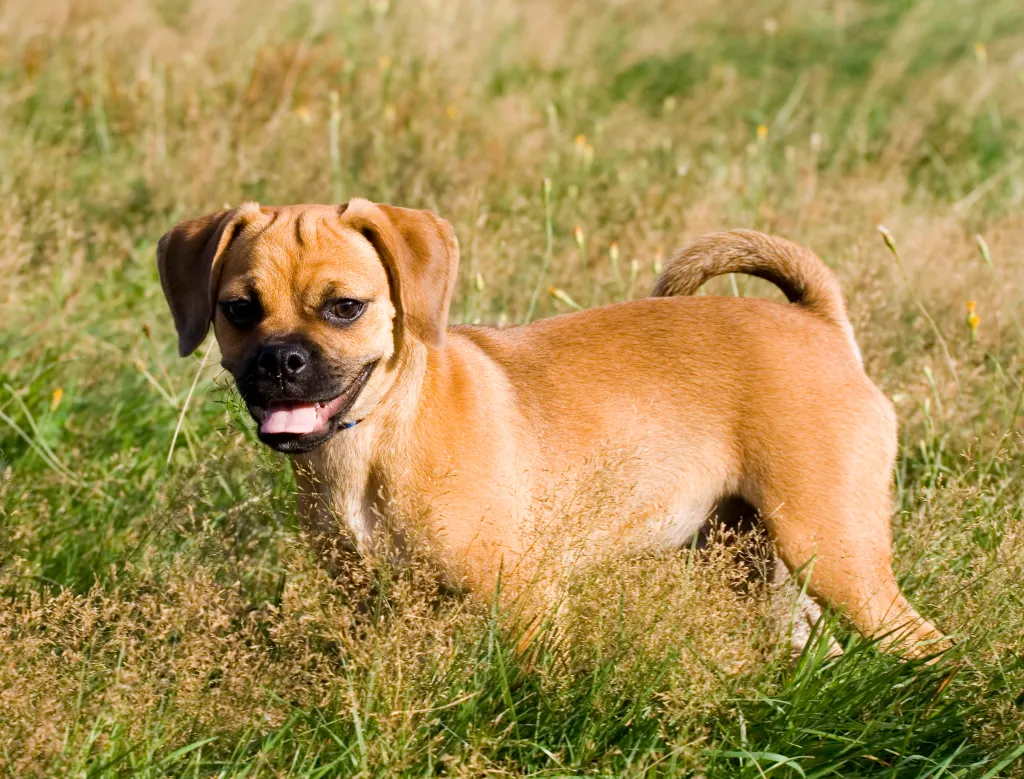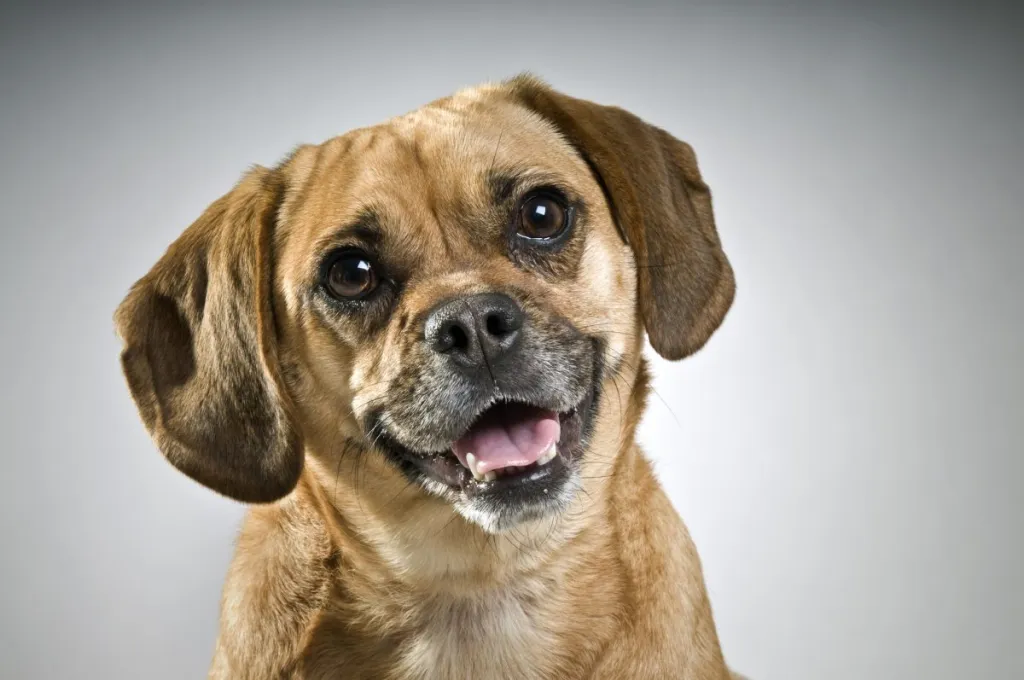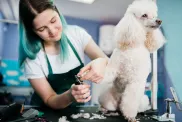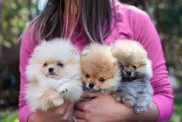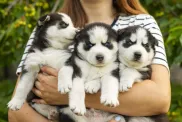The Puggle is a hybrid cross between a Beagle and a Pug that originated in the United States in the 1980s. Puggles have become increasingly popular in recent years and are known for their friendly and playful personalities. This mixed breed typically inherits the wrinkled face and compact body of the Pug, along with the longer muzzle and floppy ears of the Beagle. Puggles are known for their friendly and affectionate nature, making them excellent companions for families and individuals alike. They often have a playful and energetic personality, thanks to the Beagle’s hunting instincts, but also enjoy cuddling and lounging around like their Pug ancestors.
In terms of size, Puggles are generally considered a small to medium-sized breed, typically weighing between 15 to 30 pounds and standing about 8 to 15 inches tall at the shoulder. Their coat is usually short and dense, coming in various colors such as fawn, black, or a combination of the two, often with white markings. While Puggles can inherit some of the health issues common to both parent breeds, such as breathing difficulties or eye problems, they may benefit from hybrid vigor, potentially reducing the risk of certain genetic health issues. As with any dog, proper care, regular exercise, and a balanced diet are essential for maintaining a Puggle’s health and happiness.
Puggle characteristics
- Height: 8 to 15 inches tall at the shoulder
- Weight: 15 to 30 pounds
- Puggle Lifespan: 10 to 15 years
What does a Puggle look like?
Puggles inherit a diverse range of coat colors and patterns from their Pug and Beagle parents, resulting in various attractive combinations. The most common colors include fawn, tan, and black, often with white markings.
Coat and color variations
Some Puggles may display a mix of these colors, creating unique patterns like black and tan, or tricolor combinations. Fawn Puggles can range from light beige to a deeper reddish-brown, while black Puggles may have a solid coat or show some brindling. White markings are frequently seen on the chest, paws, and face, adding to the breed’s charm. The coat texture is typically short and smooth, though some individuals may have a slightly longer or denser coat depending on which parent breed’s genes are more dominant.
Puggle body shape:
- Build: Compact and muscular, often with a slightly elongated body compared to a purebred Pug.
- Tail: Usually curled over the back like a Pug’s, but some may have a straighter tail more like a Beagle’s.
- Coat: Short, dense, and smooth. Colors vary but commonly include fawn, black, and tan, often with white markings.
- Legs: Generally sturdy and well-proportioned to the body. Paws: Compact and round, often with well-arched toes.
Head and face:
- Nose: Can be black or brown, often with a slightly pushed-in appearance but not as flat as a Pug’s.
- Head: Usually rounded, but less extreme than a Pug’s. The muzzle is typically longer than a Pug’s but shorter than a Beagle’s. They often retain some of the Pug’s wrinkles, particularly around the forehead and muzzle, but usually less pronounced.
- Eyes: Large and expressive, often inheriting the Pug’s slightly protruding eyes but to a lesser degree.
- Ears: Frequently floppy like a Beagle’s, though some may have semi-erect ears. Usually set high on the head.
Puggle personality
Puggles are known for their charming and affectionate personalities, which blend the best traits of both Pugs and Beagles. These sociable dogs are typically friendly and outgoing, making them excellent companions for families, singles, and seniors alike. They often inherit the Pug’s love for human company and the Beagle’s curious, playful nature. Puggles tend to be energetic and enjoy moderate exercise, but they’re also content to curl up for cuddles on the couch. Their intelligence, inherited from both parent breeds, makes them relatively easy to train, although they may sometimes display a stubborn streak.
Puggles are generally good with children and other pets, thanks to their patient and gentle demeanor. However, they may inherit the Beagle’s tendency to bark or howl, especially when excited or left alone for long periods. Puggles are known for their happy-go-lucky attitude, loyalty, and ability to adapt to various living situations, making them popular choices for dog lovers seeking a lovable and relatively low-maintenance pet.
Temperament and behavior
- Friendly and sociable: Puggles are known for their outgoing nature. They typically enjoy meeting new people and other animals, making them great companions for social households.
- Affectionate with family members: These dogs form strong bonds with their families. They often seek physical closeness and enjoy cuddling, inheriting the Pug’s reputation as a “velcro dog”.
- Playful and energetic: Puggles have a good balance of energy. They’re usually up for play sessions and short walks but don’t require excessive exercise like some high-energy breeds.
- Prone to separation anxiety: Due to their strong attachment to their families, Puggles can become anxious when left alone for long periods. This may lead to destructive behaviors or excessive barking.
- Food-motivated: This trait can be very useful for training, but it also means Puggles may be prone to overeating if their diet isn’t carefully managed.
- Alert and can make good watchdogs: While not typically aggressive, Puggles are often attentive to their surroundings and will alert their owners to potential intruders or unusual noises.
Training and socialization
Early socialization and positive reinforcement training are crucial due to their intelligence and potential stubbornness. Of course, their intelligence allows them to pick up commands quickly, so early training is key to establishing good behavior from the start. Use praise, treats, and affection to reward desired behavior. Puggles respond well to positive reinforcement, and this approach will keep them motivated and engaged. As a reminder, these dogs are highly sensitive and may not be able to handle as firm of a correction as other breeds.
Training tips:
- Be Consistent: Consistency is crucial in training. Use the same commands and routines to avoid confusion. This helps your Puggle understand what is expected of them.
- Keep Training Sessions Short and Fun: Puggles aim to please but can lose interest if training sessions are too long or repetitive. Keep sessions short (10-15 minutes) and engage with varied activities.
- Mental Stimulation: Incorporate puzzle toys, obedience training, and interactive games into their routine to challenge their mind. A bored Puggle can become restless or depressed.
Puggle care
As with all dogs, it’s important to keep up your Puggle’s regular veterinary checkups to detect any health concerns early. Your vet can help you develop a care routine that will keep your dog healthy.
Puggle grooming needs
Puggles, a crossbreed between a Pug and a Beagle, have relatively low grooming needs, but they still require regular care to keep them looking and feeling their best. Here’s a breakdown of their grooming needs:
Coat care
- Brushing: Puggles have short, dense coats, and they tend to shed moderately year-round. Brush their coat 1-2 times a week to remove loose fur and reduce shedding. Use a soft-bristle brush or a rubber grooming mitt.
- Bathing: They don’t need frequent baths unless they get dirty or smelly. Bathing every 1-2 months should be sufficient. Always use a dog-friendly shampoo to avoid skin irritation.
Ear care
- Puggles’ floppy ears can trap moisture, making them prone to ear infections. Check and clean their ears weekly using a vet-recommended ear cleaner. Avoid inserting anything deep into the ear canal.
Nail trimming and dental care
- Trim their nails regularly, usually every 3-4 weeks, to prevent them from becoming too long or causing discomfort. If you’re unsure, listen for clicking sounds on hard floors—this is a sign they need a trim.
- Brush their teeth 2-3 times a week (or daily, if possible) to prevent plaque buildup and dental issues. Use a dog-specific toothbrush and toothpaste.
Facial folds and eye care
- If your Puggle inherits more Pug-like wrinkles, especially around the face, clean and dry these folds regularly to prevent infections.
- Check their eyes regularly for discharge or signs of irritation. Wipe gently with a damp cloth to keep the area clean.
Flea, tick, and parasite control
Keep up with flea and tick prevention treatments, especially if your Puggle spends much time outdoors. Regular grooming allows you to spot parasites early.
Early acclimation is key
Getting your Puggle accustomed to grooming procedures from a young age makes the process easier and more enjoyable for both of you. Handle their paws frequently, examine their mouth and ears, and reward them for good behavior during grooming sessions. This positive foundation sets the stage for stress-free veterinary exams and handling throughout their lives.
Feeding and nutrition
Feeding and nutrition are important for keeping your Puggle healthy and maintaining their energy levels.
- Meal Size: Puggles can be prone to overeating and weight gain, so it’s important to control portion sizes. Adult Puggles typically need about ¾ to 1.5 cups of high-quality dry dog food per day, divided into two meals. The exact amount depends on their age, weight, activity level, and metabolism.
- Puppies: Feed puppy-specific food designed for small to medium breeds. They may need more frequent meals (3-4 times a day) as they grow.
Nutrient balance
- Protein: Look for dog food with high-quality protein sources like chicken, turkey, beef, or fish. Protein is essential for muscle maintenance and energy.
- Fats: Healthy fats (like omega-3 and omega-6 fatty acids) are important for their skin and coat health. Moderate fat content helps maintain energy levels.
- Carbohydrates: Carbs provide energy, but make sure they come from wholesome sources like brown rice, sweet potatoes, or barley, which offer additional nutrients and fiber.
- Vitamins & Minerals: Ensure the food contains essential vitamins (like A, E, D, and B) and minerals (such as calcium and phosphorus) for bone health, immune function, and overall wellness.
Weight management
- Puggles are prone to obesity, so keep an eye on their weight. Adjust their food intake if they start gaining weight and make sure they get enough exercise.
- If your Puggle is less active, you might consider a lower-calorie or “weight management” dog food.
Puggle and family compatability
Puggles are affectionate, social dogs that form strong bonds with their families, making them great companions for households looking for a loving pet. Their playful and energetic nature, inherited from their Pug and Beagle parents, makes them ideal for families with children, as they enjoy engaging in play and interaction. Additionally, Puggles are generally good with other pets, including dogs, and they thrive on companionship. However, they can experience separation anxiety if left alone for long periods. While they are friendly and easygoing, early socialization and training are important to ensure they interact well with both children and other animals.
Compatibility with children
- Training: Early socialization and training are important to teach a Puggle how to interact properly with children, ensuring they don’t get too excitable during play.
- Great with Kids: Puggles are typically gentle and patient, making them a good fit for families with children. Their playful nature means they can be a great companion for kids, as long as interactions are supervised, especially with very young children.
- Sturdy but Small: While they’re not as fragile as toy breeds, their size (usually 15-30 pounds) makes them manageable around kids but still strong enough to handle a bit of rough-and-tumble play.
Suitability for first-time dog owners
- Great for Beginners: Puggles are often recommended for first-time dog owners due to their friendly nature, moderate care needs, and adaptability. They don’t typically have high-maintenance grooming or exercise demands, making them easier to care for compared to some other breeds.
Puggle health issues
Not all Puggles will get any or all of these diseases, but it’s important to be aware of them if you’re considering this breed.
- Stenotic Nares, also known as pinched nostrils, is a congenital disorder (meaning the dog is born with it). It affects dogs with short muzzles and makes it difficult for them to breathe. Signs include noisy breathing and exercise intolerance. Dogs that aren’t getting enough oxygen may have blue gums. Mild cases can be managed by preventing obesity, limiting exercise during hot or humid weather, and using a harness instead of a neck collar. More severe cases may require surgical repair.
- Hip Dysplasia is a heritable condition in which the thighbone doesn’t fit snugly into the hip joint. Some dogs show pain and lameness on one or both rear legs, but you may not notice any signs of discomfort in a dog with hip dysplasia. As the dog ages, arthritis can develop. X-ray screening for hip dysplasia is done by the Orthopedic Foundation for Animals or the University of Pennsylvania Hip Improvement Program (PennHIP). Hip dysplasia is hereditary, but it can be worsened by environmental factors, such as rapid growth from a high-calorie diet or injuries incurred from jumping or falling on slick floors.
- Hypothyroidism is caused by a deficiency of thyroid hormone and may produce signs that include infertility, obesity, mental dullness, and lack of energy. The dog’s fur may become coarse and brittle and begin to fall out, while the skin becomes tough and dark. Hypothyroidism can be managed very well with daily medication. Medication must continue throughout the dog’s life. A dog that is being treated for hypothyroidism can live a full and happy life.
- Patellar Luxation, also known as “slipped stifles,” is a common problem in small dogs. It is caused when the patella, which has three parts-the femur (thigh bone), patella (knee cap), and tibia (calf)-is not properly lined up. This causes lameness in the leg or an abnormal gait, sort of like a skip or a hop. It is a condition that is present at birth although the actual misalignment or luxation does not always occur until much later. The rubbing caused by patellar luxation can lead to arthritis, a degenerative joint disease. There are four grades of patellar luxation, ranging from grade I, an occasional luxation causing temporary lameness in the joint, to grade IV, in which the turning of the tibia is severe and the patella cannot be realigned manually. This gives the dog a bowlegged appearance. Severe grades of patellar luxation may require surgical repair.
- Epilepsy is a disorder that causes seizures. Epilepsy can be managed with medication, but it cannot be cured. A dog can live a full and healthy life with the proper management of epilepsy, which can be either hereditary or of unknown cause.
- Cherry Eye occurs when the gland located in the dog’s third eyelid (known as the nictitating membrane) bulges out. It looks like a reddened mass at the inner corner of the eye. Cherry eye can be repaired surgically.
Puggle rescue groups
This cross is often available at local animal shelters. You may also find Puggles through the rescue group below:

